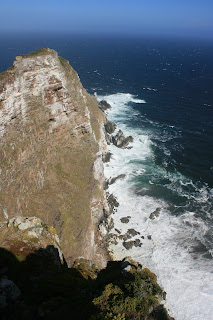With the hum of vuvezela’s long gone and the football-mad foreigners looking to the next World Cup, there’s no better time than 2011 to discover some of South Africa’s famed natural attractions. And what’s so unique about Cape Town, is that many of the city’s most remarkable mountainous wonders are concentrated in one park; the Table Mountain National Park.
Hair whips against faces and tears stream from squinted eyes,
It seems appropriate that this area was first named by 15th Century Portuguese explorers as ‘Cabo Tormentoso’, meaning the ‘Cape of Storms’. It was later renamed by King John II of Portugal to ‘Cabo de Boa Esperanca’meaning, as we know it today, the Cape of Good Hope.
The trials and triumphs of these rough waters colour many Cape folklore tales. The Cape Point funicular is named after an apparent phantom ship that met its peril in the stormy seas of the Cape and was doomed to sail the seas forever - The Flying Dutchman.
The Flying Dutchman labours the ascent of the peak at Cape Point where visitors can view the lighthouses at the summit and take in a broad view of the Cape of Good Hope .
Affectionately known as the Mother City by locals, Cape Town, with its myriad of mountains to scale, peaks to cycle, oceans to explore and wild life to observe, is a nature lover’s paradise. It’s no wonder Sir Francis Drake said, on seeing the Cape for the first time in 1580, “This cape is the most stately thing and the fairest cape we saw in the whole circumference of the earth.”
An exploration of South Africa ’s natural extremities can certainly start in Cape Town , and will inevitably include the Table Mountain National Park Cape region.

With elbows digging deep into the grass, and salty fingers propping up heads, a blanket and a bag of crisps are all the frills needed to enjoy at sunset at Chapman's Peak. Though, like some enviable and more organised Capetonians, one can always park up next one of the look-out picnic benches and salubriously ordain it with clinking wine glasses and wicker-basket-set crockery.
Here, pink and orange hues brush across the night sky, illuminating the ocean between Haut Bay and the horizon. With the shadowed mountains circling in for a look and the superfluous commentary of the onlookers softly swooning in the air, it’s a magical way to watch the night close.
Chapman’s Peak drive revels in 9 km of Cape Town
No visit to Cape Town would suffice though without ascending the iconic Table Mountain
A 360 degree rotating cable car lifts tourists swiftly to the 1087m tall summit where the view of the city, it’s coastline and mountainous inlands is boastfully breath-taking. Venturing past families carefully posing for album photographs and reflective explorers diarising their thoughts, a stroll of Table Mountain will reveal some of Africa’s native flora and fauna. There are numerous hikes, walks and sleeping tours, for the more adventurous types, all over the Table Mountain National Park
Ditching the sneakers and donning designer sandals, travellers of any heel at Camp’s Bay can enjoy the sloping ridges of the Table Mountain
 With South Africa’s outstanding performance as host of the 2010 Soccer World Cup, the country’s ball of treasures was kicked into the limelight. As much as soccer sportsmanship took the centre stage, so too did the prowess of South Africa’s nature; in all its wild and rugged beauty. For those who watched with envy as the lucky punters of the World Cup climbed Table Mountain, conquered Cape Point and cocktailed in Camps Bay, now’s your chance to really discover Cape Town; and there won’t be any vuvuzela’s to distract you.
With South Africa’s outstanding performance as host of the 2010 Soccer World Cup, the country’s ball of treasures was kicked into the limelight. As much as soccer sportsmanship took the centre stage, so too did the prowess of South Africa’s nature; in all its wild and rugged beauty. For those who watched with envy as the lucky punters of the World Cup climbed Table Mountain, conquered Cape Point and cocktailed in Camps Bay, now’s your chance to really discover Cape Town; and there won’t be any vuvuzela’s to distract you. Some pointers:
Camps Bay - arrive early to find a parking spot
Cape Point, Cape of Good Hope and Table Mountain National Park – 80 Rand per adult per day, approximately 42 AED - (Price until 31 Oct 2011)
Table Mountain – 180 Rand, Cableway return ticket, approximately 95 AED - (Single return adult, price as of 26/01/11)
Chapman’s Peak Drive - 28 Rand toll, approximately 15 AED






